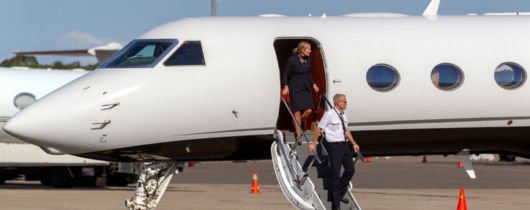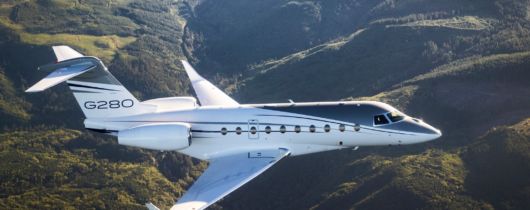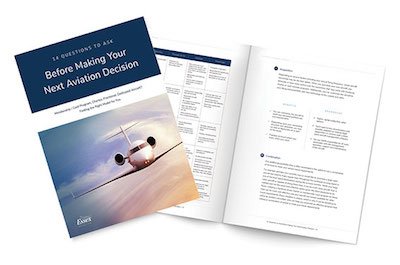
The United States is home to some 22,000 aircraft registered to private owners, making it the largest business aircraft market in the world. In the current market, the demand for pre-owned aircraft exceeds the available supply, leading many would-be aircraft owners to consider acquiring aircraft available for purchase in foreign markets.
Should a buyer based in the U.S. choose to purchase an aircraft from overseas, they’ll need to import that aircraft through U.S. Customs. In this article, written in partnership with Tobias Kleitman at TVPX, we’ll discuss the entire aircraft import process in detail.
Making Sense of Aircraft Imports
There’s some confusion around what it means to import an aircraft. The reason for this is there are technically two forms of aircraft imports: The first involves exporting an aircraft off of a foreign registry and importing it onto the U.S. registry. The second involves exporting an aircraft out of a foreign country and importing it through U.S. Customs when it arrives in the U.S. Both forms of aircraft imports are necessary for U.S.-based buyers looking to purchase an aircraft overseas, but register it on the U.S. registry and operate it within the U.S.
The Prevalence of Cross-Border Transactions
As the United States is the world’s largest market for aircraft, demand regularly outstrips available supply. This imbalance has led to an increase in cross-border transactions in which buyers purchase foreign-registered aircraft, import them into the U.S. and register them on the U.S. registry.
Another major factor contributing to the rise in aircraft imports onto the U.S. registry is that registering an aircraft in the U.S. can potentially increase its resale value or make the aircraft more attractive to potential buyers, as opposed to a currently foreign registered aircraft.
The Federal Aviation Administration (FAA) has stringent safety requirements and maintenance standards, which are internationally recognized, respected and often replicated by foreign registries. Aircraft maintained according to these standards are often able to secure a higher resale value; these standards also allow for an easier transfer of ownership, which makes U.S. aircraft import and registration an attractive option.
If a private aviation consultant identifies a candidate aircraft in a foreign country that seems like a good prospect for their client, they’ll work with their client to submit a letter of intent and negotiate a purchase sale agreement on their behalf. When purchasing an aircraft from a foreign seller, buyers can either close the sale overseas and import it through U.S. Customs after the fact or the seller import the aircraft prior to final purchase.
Breaking Down the Aircraft Import Process
As noted, there are two distinct aircraft import processes, both of which take place concurrently; they are as follows:
Importing Aircraft Through U.S. Customs
- Identify the Importer of Record (IOR). The IOR is an individual or entity that assumes legal and financial responsibility for the imported aircraft and arranges Customs documentation, pays any applicable fees and arranges Customs clearance. Any individual or entity with a financial interest in the transaction can serve as the IOR.
- Retain and convey Power of Attorney for the services of a licensed U.S. Customs broker. A Customs broker is a professional or company that specializes in facilitating Customs clearance. They act as an intermediary between the importer and Customs authorities, ensuring compliance with Customs regulations and requirements. Once an importer has selected a Customs broker, they grant them power of attorney to represent them.
- Secure a Customs bond. A Customs bond, also known as a surety bond or an import bond, is a financial guarantee required by U.S. Customs authorities when importing an aircraft into the country. It effectively serves as a guarantee that the IOR will comply with all Customs regulations, pay any applicable fees and fulfill all obligations related to the aircraft import process. The buyer’s Customs broker will secure a Customs bond on their behalf.
- Gather information. Once they’ve obtained a Customs bond, the Customs broker will then gather information to fill out and file any necessary forms, including CBP Form 3461 (Customs Release) and CBP Form 7501 (Customs Entry). By coordinating everything prior to the aircraft’s arrival, the Customs broker makes it easier for U.S. Customs to sign off on the aircraft import, and for the aircraft to travel onward to its final destination.
Importing Aircraft onto the U.S. Registry
- Initial Evaluation
As with any aircraft purchase, the aircraft import process begins with a pre-purchase inspection. During this inspection, the buyer’s FAA Designated Airworthiness Representative (DAR) will examine the aircraft and review its historic records, current maintenance status, Airworthiness Directives and various other items to determine its eligibility for an FAA Certificate of Airworthiness and registration.DARs are independent maintenance contractors authorized by the FAA to administer Airworthiness Certificates and Aircraft Registrations, should the aircraft meet the FAA’s requirements. Although DARs are appointed by the FAA, they do not work for the FAA; instead, they are independent contractors granted approval to work within a specific region.If the DAR deems that the aircraft in question meets the FAA’s standards, the transaction may proceed as normal, and the buyer will receive a signed Airworthiness Certificate once the aircraft is registered in the U.S. If, however, the aircraft does not meet the FAA’s standards, the DAR will inform the buyer of any issues with the aircraft that prevent it from being deemed airworthy and that must be corrected. These issues can range from minor discrepancies, such as a missing placard, to more expensive upgrades, such as adding an annunciator panel to the cockpit.Unlike a traditional, domestic pre-purchase inspection, with an aircraft import the buyer cannot make any changes to the aircraft until after closing, exportation/importation and deregistration from the foreign registry are complete.
It’s important that the buyer be aware of any changes that need to be made to the aircraft in order to avoid unexpected expenses as part of the transaction or unexpected downtime following closing. This also enables the buyer to choose an appropriate facility — one capable of making the necessary modifications to ensure airworthiness —for final closing and delivery. A DAR can work with the buyer’s facility of choice and oversee any modifications to the aircraft.
- Drafting a Purchase Agreement & Pre-Purchase Inspection
The buyer’s acquisition team will work with the seller’s aircraft broker to negotiate a purchase agreement. Similar to traditional purchase agreements for domestic transactions, the purchase agreement will provide specific instructions, detail protections and payment structure, and outline final delivery.If, during the pre-purchase inspection, the inspection facility were to identify any discrepancies with the aircraft that prevent it from being deemed airworthy, from meeting the delivery conditions defined in the purchase agreement or from being able to receive an Export Certificate of Airworthiness from its current registry, the seller will be required to clear those discrepancies prior to closing. - Deregistration
Once the pre-purchase inspection is complete and both parties have confirmed that the aircraft meets delivery conditions, the seller will begin the process of deregistering the aircraft from its current country of registration.For this step of the aircraft import process, the seller must provide an Export Certificate of Airworthiness issued by the Current Aircraft Registry Authority of the aircraft. The Export Certificate of Airworthiness signals to the buyer’s DAR that the aircraft is fully up to date and meets all of the Exporting Authority’s requirements for exportation and removal from its foreign registry.If an aircraft has any outstanding items or discrepancies, the Exporting Authority will not issue an Export Certificate of Airworthiness, preventing the seller from deregistering the aircraft from its country of origin and the buyer from re-registering it in the U.S. Again, if an aircraft fails to receive an Export Certificate of Airworthiness, the seller will be required to make the necessary modifications to the aircraft.In order to avoid any potential issues at this stage, it’s imperative that the buyer’s acquisition team work closely with the seller’s aircraft broker to ensure that everyone is on the same page and understands all components of the aircraft import process. If one party is unfamiliar with the process, it could lead to issues for one or both parties.
- Completing the Transaction
Once the seller has confirmed deregistration with the FAA, the DAR will sign and issue an FAA Airworthiness Certificate. Once the buyer has received an Airworthiness Certificate for the aircraft, the closing process may proceed.The closing process for aircraft imports is fairly standard — both the buyer’s and the seller’s transaction teams will work with a third-party escrow company or FAA legal counsel to file the closing documents and oversee the final transfer of aircraft title.
| FAA Aircraft Reregistration — What You’ll Need |
|
Key Considerations Prior to Importing an Aircraft
For prospective buyers debating whether to acquire a pre-owned aircraft that is already located and registered in the U.S. or to acquire an aircraft located outside the country, there are a few key things to consider.
- First and foremost, buyers will want to consider which aircraft make and model aligns most closely with their particular travel requirements. This is an important consideration in any search for the right aircraft and will give you a better understanding of what options are available to you, either in the U.S. or the foreign pre-owned business aircraft market. A qualified private aviation consultant can work closely with you to define your requirements, determine suitable options and even identify available aircraft that meet your requirements within the market.
- A private aviation consultant is just one member of the buyer’s acquisition team. To get the support they need to complete an aircraft import, buyers will also want to retain the services of a DAR, aviation legal and tax counsel and a Customs broker. It’s worth noting that these professionals may charge international transaction fees for aircraft import services in addition to their standard fees.
- If an aircraft is imported into the U.S. for pre-buy and the deal falls through for any reason, the aircraft will need to be exported upon departure by the party that is controlling the movement of the aircraft (likely the foreign seller). This filing will effectively cancel out the import filing from a trade statistics perspective.If, however, the aircraft remains in the U.S. for resale, the seller does not need to take any additional action.
- Observing the proper process and protocols for importing an aircraft through U.S. Customs is essential for resale purposes. If a buyer attempts to purchase an aircraft that has no record of being imported through U.S. Customs, it can create logistical and legal issues that need to be resolved prior to closing
- Finally, prospective buyers will want to consider whether they intend to register their aircraft with the FAA using an aircraft trust. This is especially important consideration for any buyer who does not meet the FAA’s citizenship requirements.







